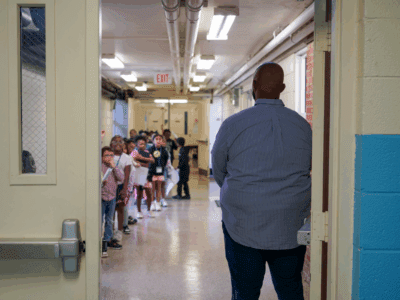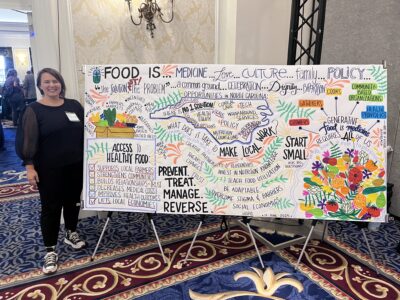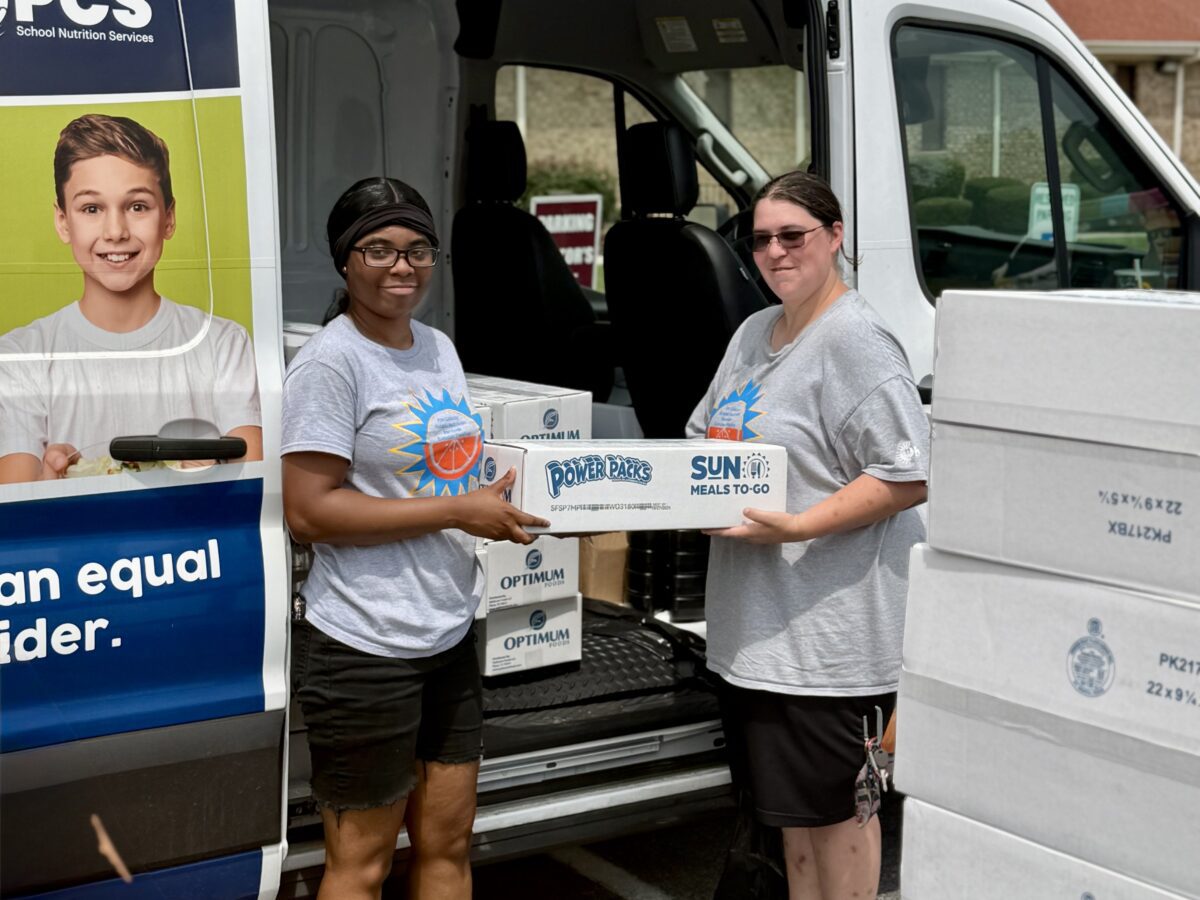
Editor’s note: This article was updated on Oct. 22 with additional resources from the Carolina Hunger Initiative.
When school lets out for the summer, efforts to feed students don’t end.
Almost 1 million North Carolina students qualify for free or reduced-price school meals, which they lose access to when school is out. Summer meals programs work to fill that gap. In 2024, more than 4.2 million summer meals were served across the state.
And, thanks to a new federal program for rural communities, some North Carolina school districts served significantly more summer meals in 2025 compared to the previous year.
![]() Sign up for the EdWeekly, a Friday roundup of the most important education news of the week.
Sign up for the EdWeekly, a Friday roundup of the most important education news of the week.
Since the 1960s, the federal government has provided funding for nonprofits, school districts, and other agencies to serve summer meals to children ages 18 and under through the Summer Food Service Program (SFSP), also called SUN Meals.
Historically, children were required to eat summer meals on-site, such as at a public park, library, or day camp. This requirement, also called congregate feeding, creates numerous barriers to access, particularly in rural communities. Children without transportation during the day often can’t reach summer feeding sites, and parents with limited time may not be able to remain on site while their children eat meals.
“The data has shown again and again that the number one challenge is transportation. How do you get the kids to the meals or the meals to the kids?” said Tamara Baker, project and communications director for Carolina Hunger Initiative. “You couldn’t get the meals to the kids unless you were holding a congregate site in their neighborhood, and that was challenging.”
Beginning in the summer of 2023, new federal legislation provided a solution: Summer meals sponsors in low-income, rural areas are now allowed to provide meals that can be eaten off-site, also called non-congregate meals or SUN Meals To-Go.
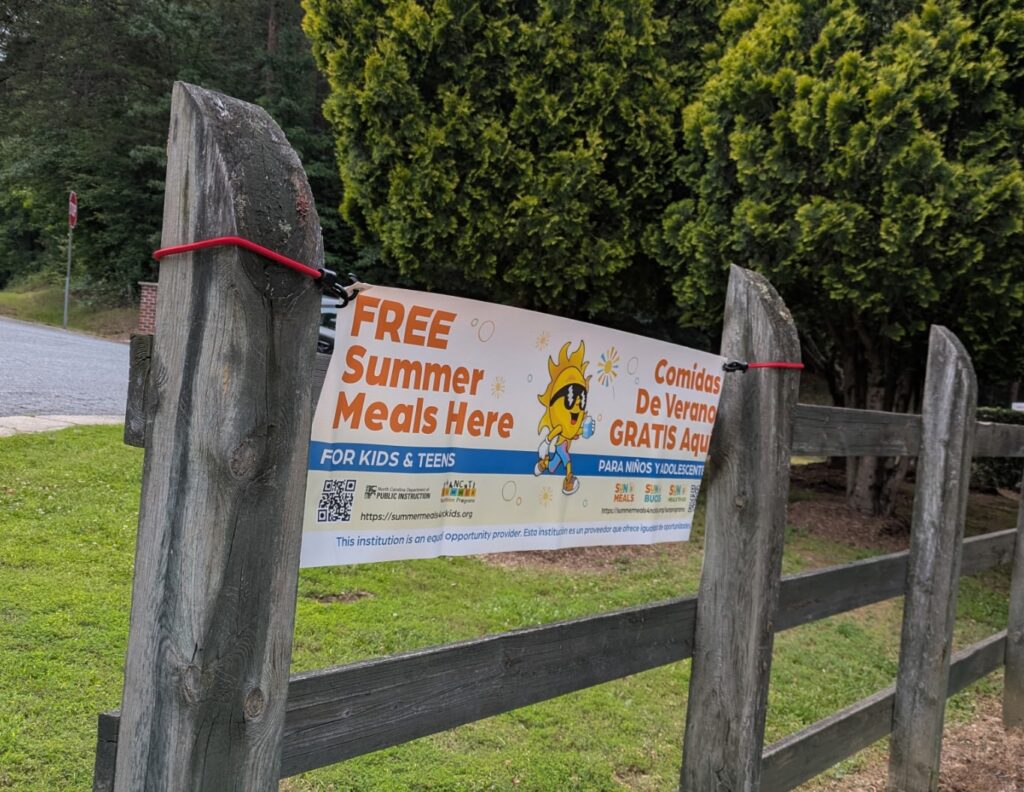
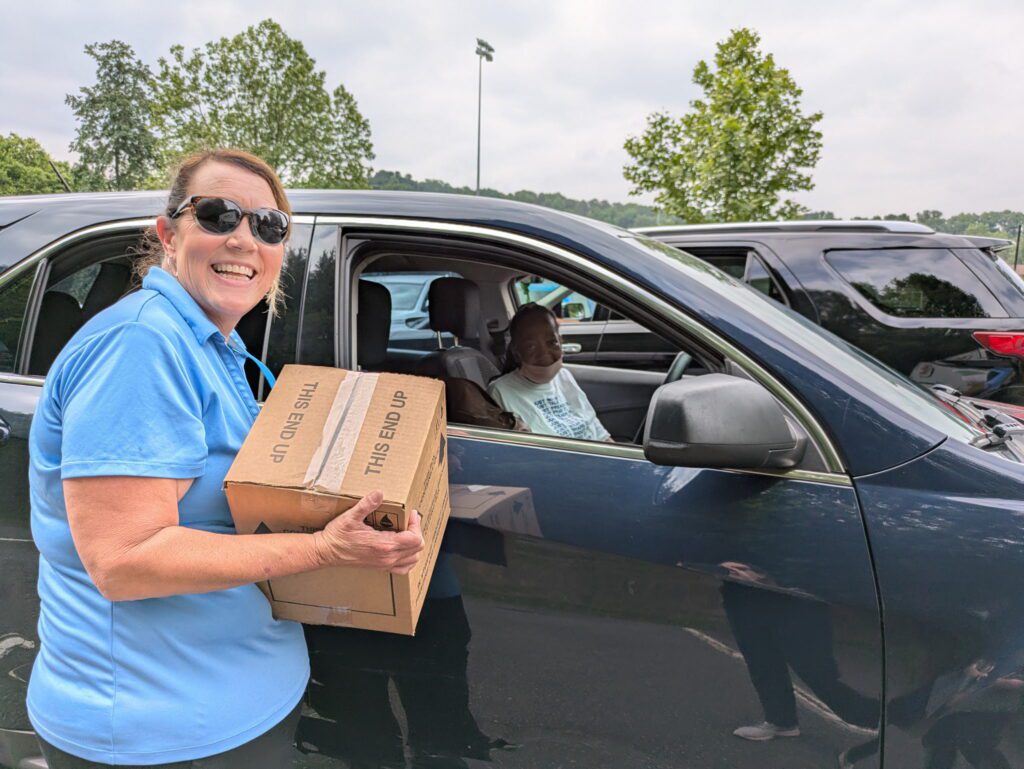
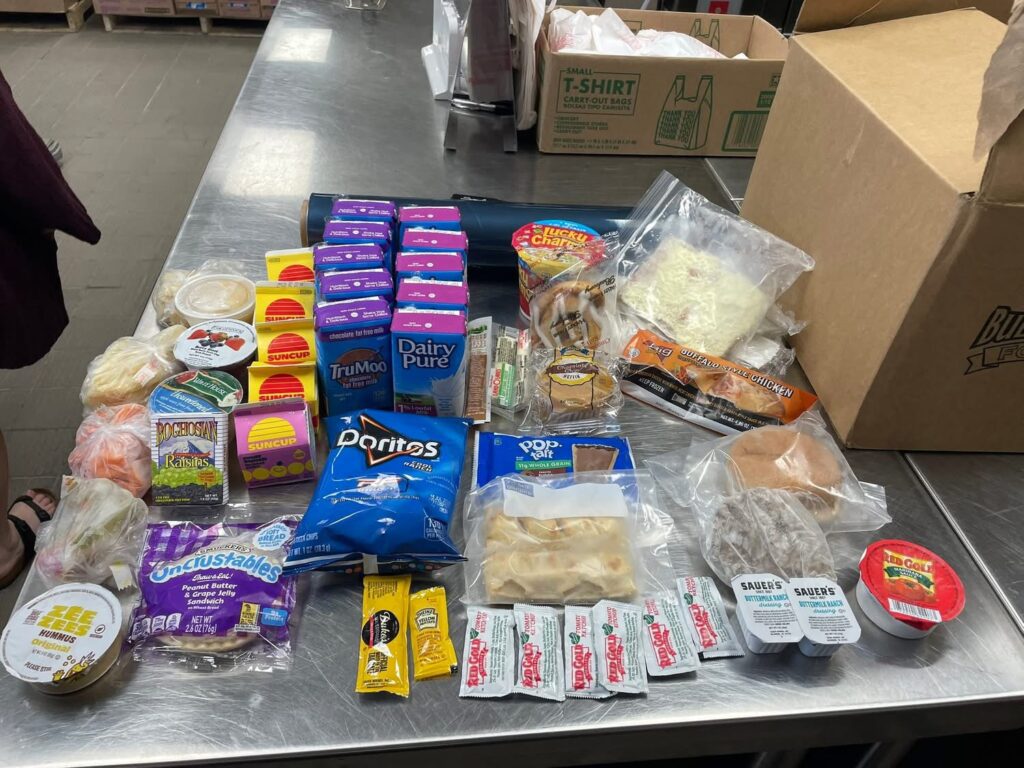
This flexibility allows approved summer meals sponsors to provide meals through a variety of models, including drive-thrus, pick-up lines, or home delivery, without requiring the child receiving the meals to be present. It also allows sponsors to provide families with multiple days worth of meals, for all children in their household, at one time.
For example, many SUN Meals To-Go sponsors provide a weekly bundle of five to seven days worth of breakfasts and lunches for each child, consisting of shelf-stable or frozen food items that won’t spoil.
Participation in SUN Meals To-Go has grown rapidly. According to the Carolina Hunger Initiative, there were eight sponsors participating in the summer of 2023, 33 sponsors participating in the summer of 2024, and 43 sponsors participating in the summer of 2025.
In three North Carolina school districts — Hickory City Schools, Johnston County Public Schools, and Pitt County Schools — serving non-congregate summer meals resulted in the rapid growth of their summer meals programs. In the summer of 2025, the first year these districts offered SUN Meals To-Go, they served anywhere from twice as many to 14 times as many summer meals compared to the previous year.
For example, in Johnston County Public Schools, about 15,000 summer meals were served in 2024. That figure rose to approximately 224,000 summer meals in 2025 — driven in large part by the more than 212,000 non-congregate meals the district served through SUN Meals To-Go.
Here’s what leaders of these summer meals programs shared about setting up SUN Meals To-Go programs, staying flexible amid unpredictable demand and weather, fostering partnerships to provide additional resources, and meeting community needs.
Read more about school nutrition
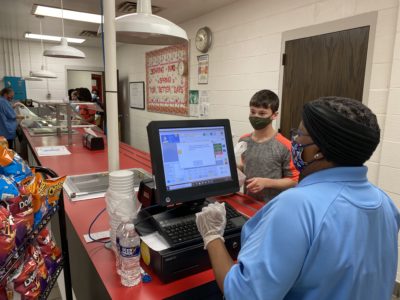
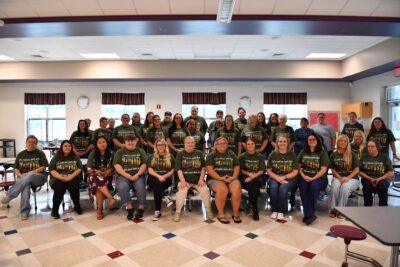
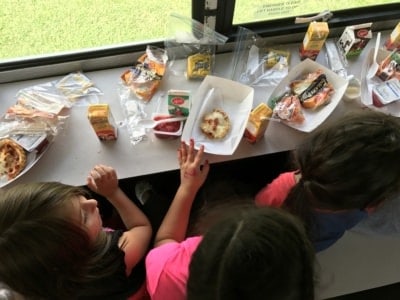
Setting up a SUN Meals To-Go program
To be eligible to serve SUN Meals To-Go, the site’s location must meet two criteria:
- It must be located in a census tract that is designated as eligible for the Summer Food Service Program, shown in green on this map. If at least 50% of the population in the census tract qualifies for free- or reduced-price meals, then that census tract is eligible for the SFSP.
- It must be located in an area designated as rural by the U.S. Department of Agriculture (USDA), shown in green on this map. Note that although counties such as Johnston, Catawba, and Pitt are classified as “suburban/regional city” by the NC Rural Center, there are still USDA-designated rural areas in each of these counties that allow for the operation of SUN Meals To-Go.
Sponsors who meet these eligibility requirements then go through an application process with the North Carolina Department of Public Instruction (DPI), which administers the SFSP using federal funds. Applications for the following summer are accepted from Nov. 1 to March 1.
According to the Carolina Hunger Initiative, first-year SFSP sponsors in North Carolina aren’t eligible to operate SUN Meals To-Go. Instead, they need to operate a congregate feeding site for at least one year before applying. This map shows all summer meals sites that operated in 2025.
Once a SUN Meals To-Go site is approved, sponsors spend time attending DPI trainings, hiring staff and volunteers, and preparing for how meals will be served.
Given the nature of SUN Meals To-Go, extra steps are taken to ensure program integrity. For example, sponsors must create processes to ensure that there is a child connected to each parent receiving meals and that parents are not collecting meals from multiple sites for the same child. However, the children served don’t have to be public school students — any child ages 18 and under is eligible to receive meals, regardless of where they live or what type of school they attend.
“The meal sponsors have gotten really creative in how they follow that integrity plan to assure that the children indeed are getting the meals and everything is operating as it should,” said Baker.
This often looks like asking families to pre-register for meals through a digital form and then verifying their registration when they arrive to pick up meals. In Pitt County Schools, the summer food service team would compare the roster of SUN Meals To-Go registrations to lists of children enrolled in other congregate summer meals programs to ensure there was no overlap.
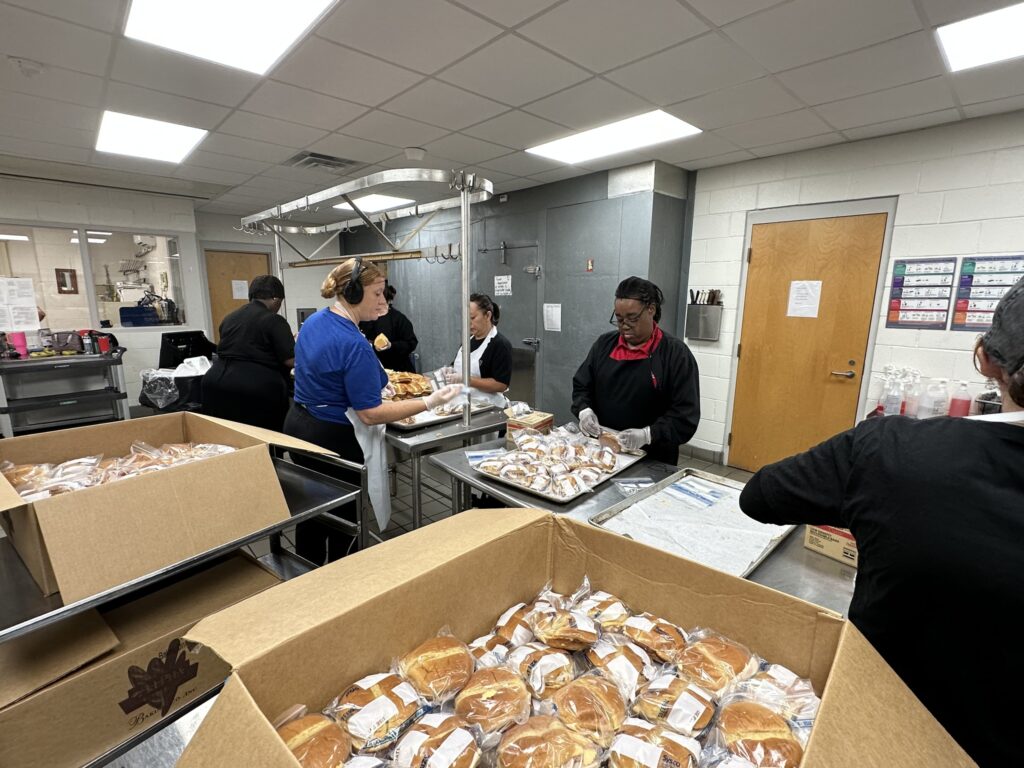

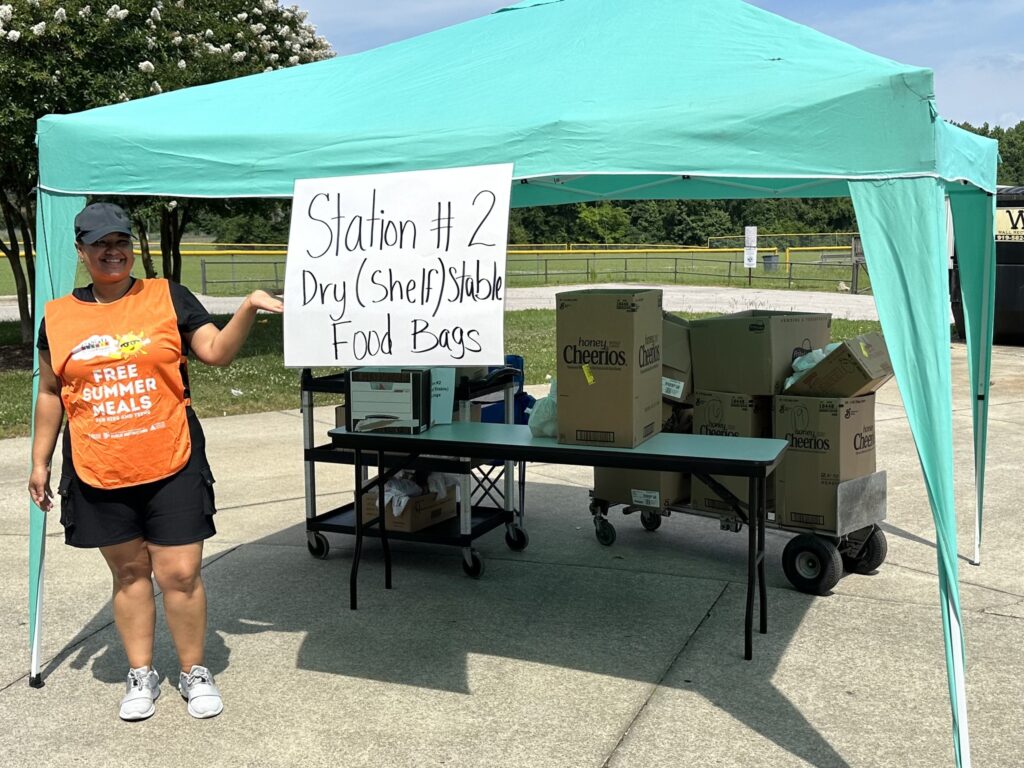
Staying flexible amid unpredictable demand and weather
If you speak with any sponsor of a summer meals site, they’ll likely tell you that flexibility is key to success.
That is even more so the case for new SUN Meals To-Go programs. It’s often hard to predict demand, sites are usually operated outdoors in all elements of weather, and the logistics of moving hundreds of cars through pick-up lines — all without blocking local traffic — can be complex.
Operating SUN Meals To-Go for the first time this year, leaders in Johnston County, Pitt County, and Hickory City schools all said demand far exceeded what they had planned for. In the third week of Hickory City Schools’ drive-thru program, roughly 800 boxes were provided to families, each containing five frozen breakfasts and five frozen lunches.
“We planned for 100, 150, 200 — we never expected that it would be that large, and that big of a need,” said Christy Gwyn, school nutrition director for Hickory City Schools, adding that the site had to move from one side of a park to the other to create more space for the drive-thru line.
After Johnston County Public Schools collected its first week of registration forms, more than 1,800 cars were signed up to pick up meals. School nutrition leaders quickly realized the two-hour pickup window they had originally planned for would not be nearly long enough, so they extended the pick-up time from 12 p.m. to 6 p.m. Then came the complications of bad weather.
“It was our first day, and it was raining, so all our computers and the Wi-Fi couldn’t be reached. It was hot and rainy and we were all very wet and very scared, but we succeeded,” said Yadira Creech, school nutrition supervisor in Johnston County Public Schools. That day, 33,500 meals were picked up by families, the biggest single day in Johnston County’s SUN Meals To-Go program.
In the second week of the SUN Meals To-Go program in Pitt County, cars were lined up for hours before distribution opened, and the site quickly ran out of meals.
“We instantly ordered more boxes to make sure we could accommodate for the extra need. We got another van there, we got more staff there,” said Nicki Frey, school nutrition supervisor in Pitt County Schools. “We instantly adjusted to make it work.”
“These directors that are running the program are real problem-solvers, and they are adapting to the needs of the community plus what issues may arise — if there’s parking issues, or traffic issues coming out the door, or the wrong milk got delivered, or different heat waves that have happened and keeping your staff safe,” said Jana Saur, a program specialist for Carolina Hunger Initiative. “People are getting thrown in the deep end, and they’re swimming.”
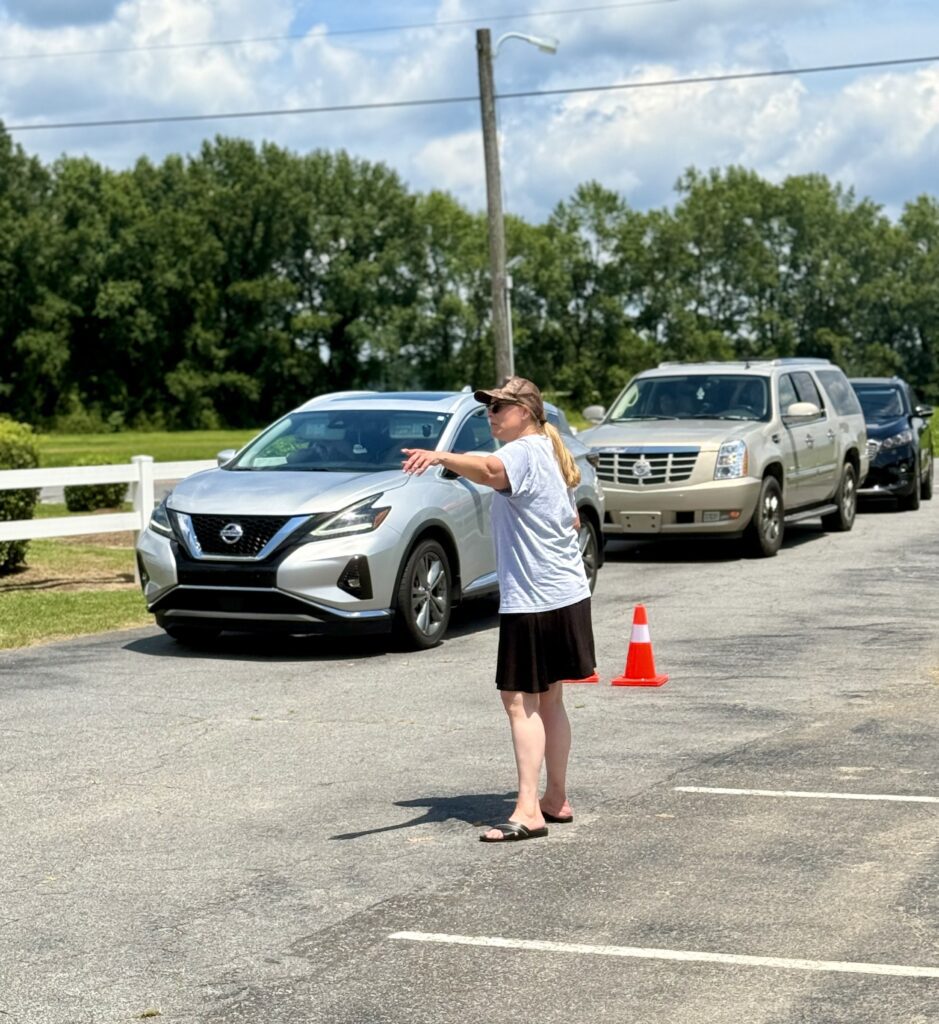
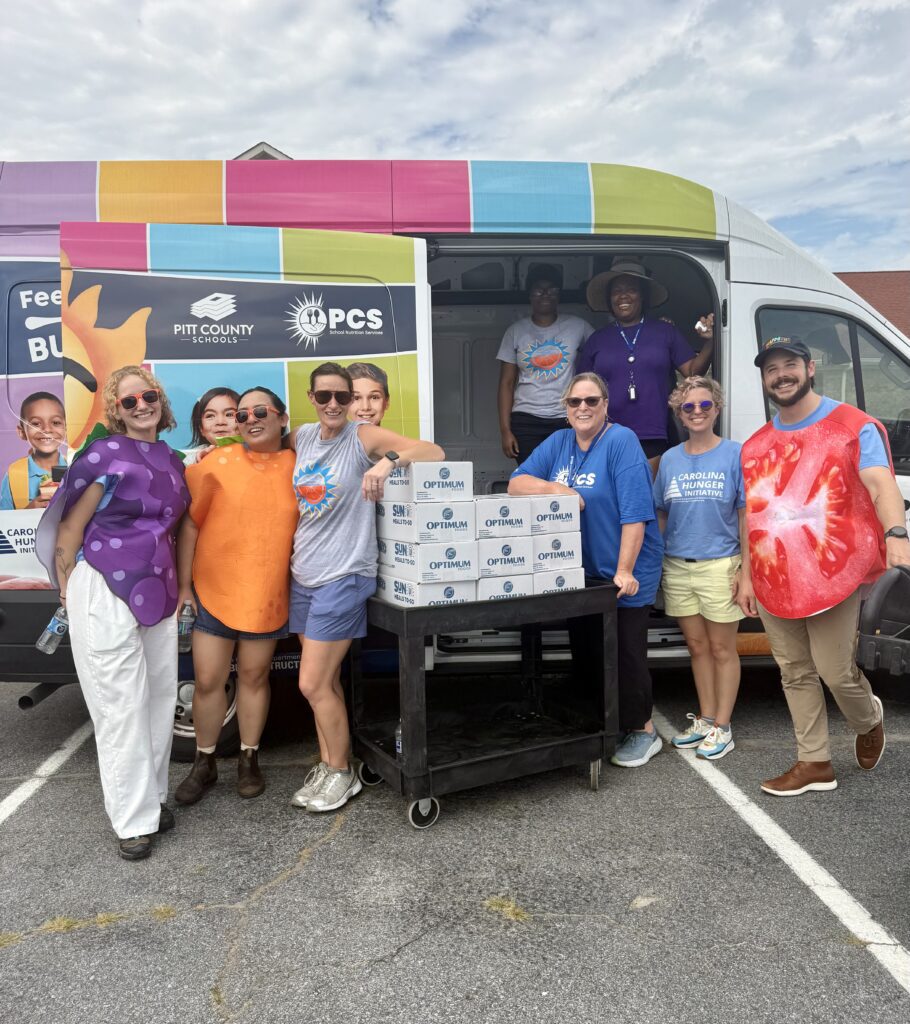
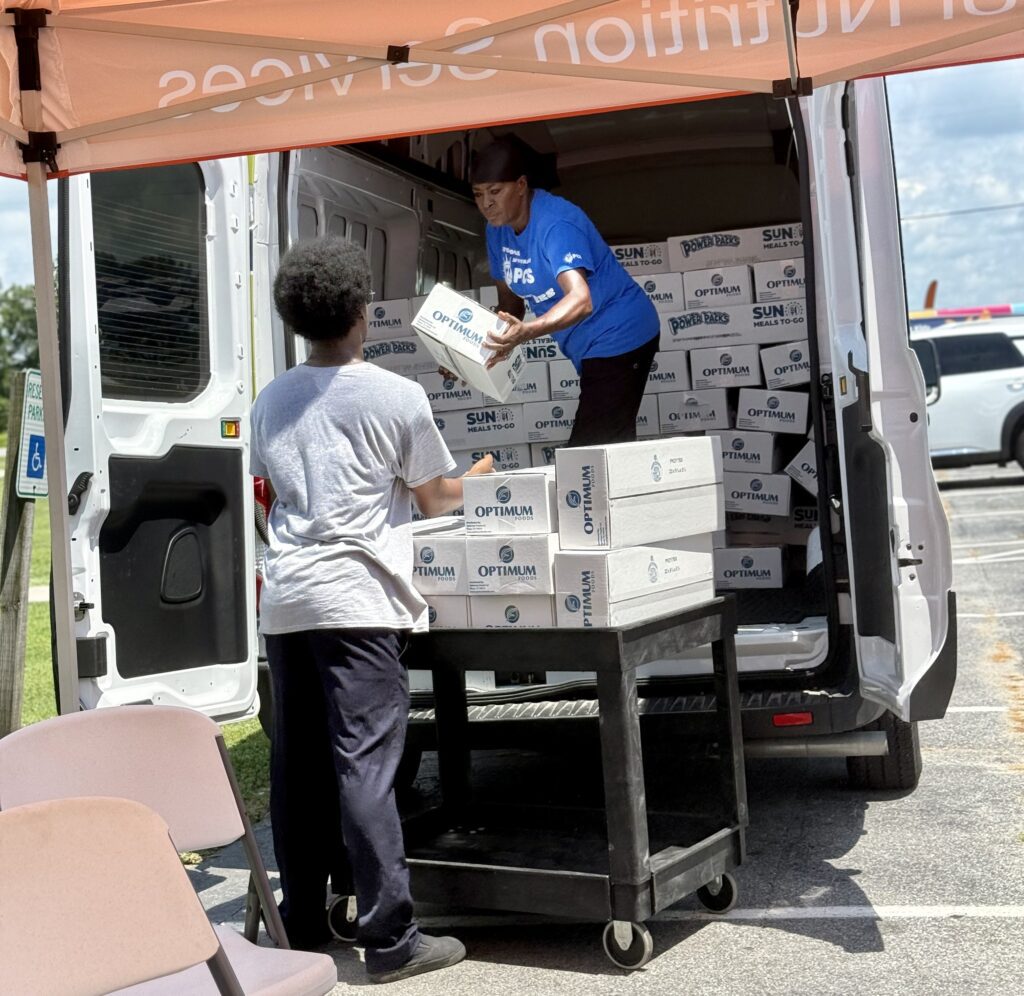
Fostering partnerships to provide additional resources
Given the manpower needed to distribute meals to families and due to the added cost of hiring staff, many SUN Meals To-Go sites rely on volunteers to operate.
“Our volunteers were rock stars,” said Jennifer Lawson, executive director of school nutrition services in Johnston County Public Schools. “I don’t know that we would have been able to pull it off with the amount of staff we had, if it really wasn’t for those volunteers.”
When Hickory City Schools saw far more demand for SUN Meals To-Go than expected, it became a community-wide volunteer effort to keep the program operating smoothly. Even her own family members stepped in to help.
“We pulled out all the stops — whatever we had to do to feed the kids,” said Gwyn. “We asked for volunteers to pack boxes — community partners, our district leaders, our teachers, lots of folks … we just all came together to make sure the program was a success.”
Beyond engaging volunteers, many summer meals sites offer other supportive services to families, providing a one-stop touch point to meet their needs.
Pitt County Schools partnered with Ripe for Revival, a nonprofit that runs a mobile market truck that offers fresh fruits and vegetables, eggs, milk, meat, and other food products on a pay-what-you-can scale. After picking up bags of shelf-stable summer meals, families had the option to stop by the Ripe for Revival truck to select fresh products. External sponsorships covered the cost of the truck at both of Pitt County’s SUN Meals To-Go sites, which is usually $750 per site per week.
They also partnered with Blue Cross Blue Shield, which sent staff to both distribution sites each week to offer giveaways and provide pamphlets with information on topics related to health care. Next year, Pitt County Schools is interested in offering on-site blood pressure checks and other services to encourage community members to come to the site.
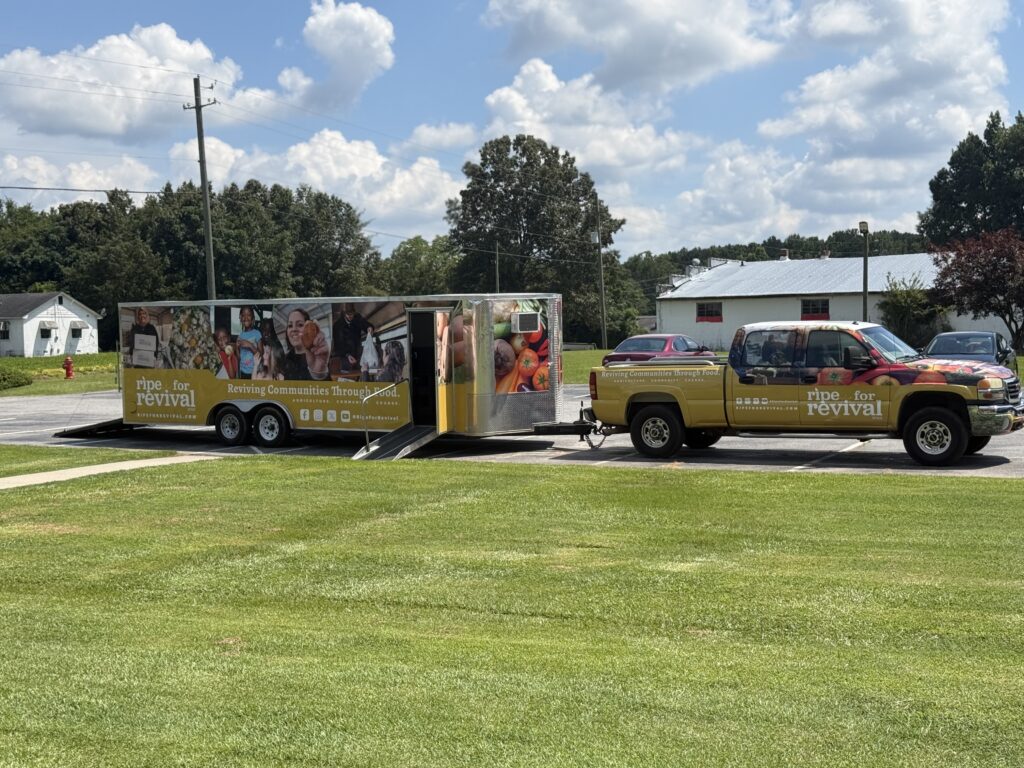
Meeting community needs
To run a successful SUN Meals To-Go program, school nutrition leaders in Pitt County Schools emphasized the importance of thinking outside of the box and designing programs that meet specific community needs. For example, Pitt County Schools is not all rural, so the program had to be carefully designed to stay within federal regulations.
“I got very good tips from other people, but you have to work with what you have. Sometimes that can be a little scary, because you don’t know if you’re doing it right or wrong,” said Frey. “But once you get over that initial (feeling) of, ‘I’m not really sure what I’m doing,’ it’s kind of a lot of fun.”
In addition to feeding children, Gwyn said operating SUN Meals To-Go has provided needed employment for school nutrition staff during the summer months and has improved her program’s financial sustainability. Higher federal reimbursement rates for summer meals help cushion the school nutrition budget, allowing her to purchase new equipment and serve higher-quality meals during the school year.
“It’s a win-win for everyone — most importantly, the kids have access to meals in the summer, our school nutrition employees have the opportunity to work, and our school nutrition department can earn funds that help sustain us throughout the school year,” she said.
In Johnston County, positive feedback on the SUN Meals To-Go program came in part from the districts’ own teachers who picked up meals for their children.
“People that are working in our very own school district struggle,” said Lawson. “To hear our community have such this amazing response, not only to just the service but also to the products that we offered … it was a very rewarding opportunity for us to be able to extend that service to the school district.”
However, Lawson said some children’s needs are still unmet due to federal regulations that require SUN Meals To-Go to operate only in rural areas.
“I think that non-congregate needs to be available throughout all school districts, so that we have that outreach in every community and every child has an opportunity to receive that meal over a time that they’re not receiving school meals,” she said.
Gretchen Wilson, school nutrition director in Pitt County Schools, said grant funding was critical to ensuring her SUN Meals To-Go program could cover all necessary costs. She hopes that additional grants or state funding will be available in the future to supplement federal reimbursement and help other sponsors launch similar programs.
“It’s just a great opportunity,” said Wilson. “The school system will benefit, the community will benefit, and therefore the students will be ready to learn when they come back, because they won’t just be hungry all summer.”
Resources
summermeals4nckids.org hosts a variety of resources related to summer meals, including tools to find meals for kids and promotional materials for sponsors. On the SUN Meals To-Go page, you’ll find detailed explanations of each non-congregate meal service model, including:
Recommended reading
